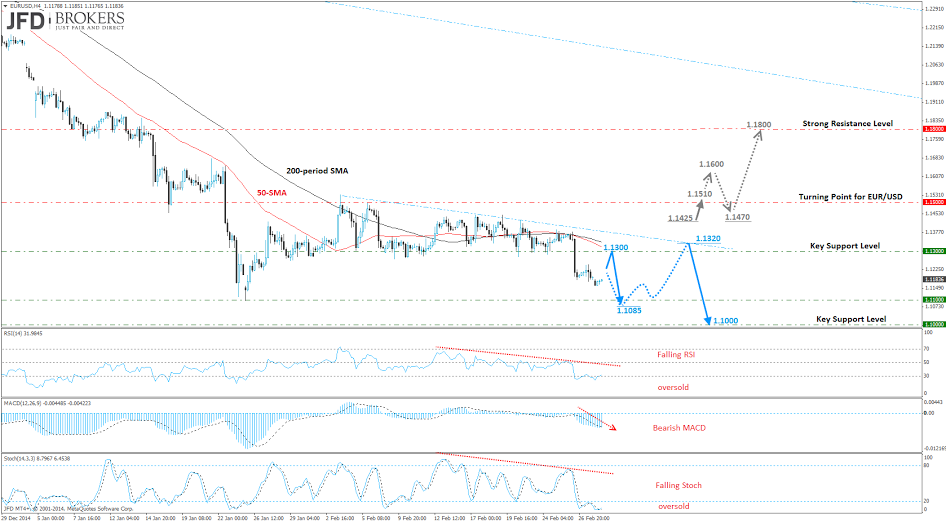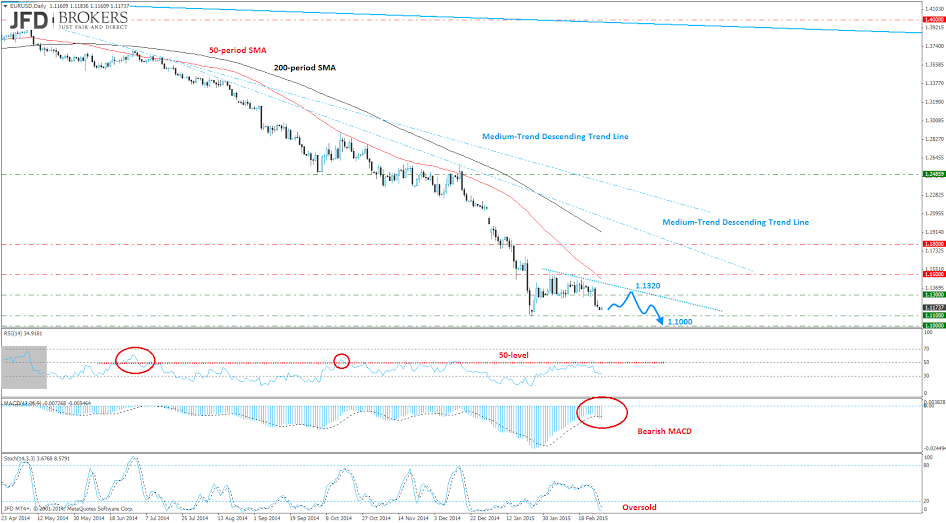The shared currency has fallen for an eight consecutive month against the greenback, after testing the psychological level of 1.4000, which dates back to 04 May 2014. In fact, this is the biggest consecutive drop in EUR/USD history, over 25 years of price collection.
Thursday’s ECB meeting is likely to have a significant impact on the direction of the pair, including the all-important US Non-farm Payrolls on Friday. The ECB currently holds a negative interest rate and is the first major central bank which is turning to a bond-buying program, similar to the one used by the US and Japan, by maintaining rates in a negative territory and the deposit rate at -0.2% since September 2014. ECB’s President Mario Draghi introduced the negative rates back in September 2014 in order to prevent a slide into deflation. Euro-area inflation surprisingly deteriorated in January to -0.6%, the lowest since July 2009, just below the ECB’s target close to 2%.
Furthermore, the ECB pumped EUR 1.1 trillion of extra money into the economy through QE, also a move from the ECB to tackle deflation. Nobody expects these measures to have an impact in the short-term, as the ECB forecasts inflation to pick up at 0.8% in 2015 and 1.2% in 2016. While the ECB launched its large programme of QE and inflation fell below zero for first time since 2009, this caused investors to turn aggressively bearish against the euro. The euro dropped to the lowest level in almost 15 years against the dollar following the ECB QE announcement, with the EUR/USD pair marking its eighth consecutive month of losses.
Moreover, despite the recent weaker-than-anticipated inflation and activity data, including falling figures in Business Climate, Industrial Production, Industrial Confidence, Service Sentiment and Consumer Confidence we expect the ECB to keep its benchmark interest rate unchanged at a record low of 0.05% at its March meeting.
Technically speaking, the EUR/USD has been struggling with the psychological level of 1.1500 for the last few weeks, where the 50-period SMA, as well as the 200-period SMA, provided a significant resistance to the price action slightly below the 1.1500 region. Furthermore, over the last couple of weeks, the pair is trading in a tight range roughly around the 1.1300 level.
Going forward, the medium and long term trend remains a downtrend since the rate still lies below the descending trend line which started back in May 2014. The MACD is also looking bearish having remained in bearish territory for some time now while the Relative Strength index is moving below 50 since May 2014, except from two occasions.
Given the current negative environment for the euro, I am uncertain as to what could likely give further strength to the bulls and drive the price back above the key resistance level of 1.1500. Therefore, as it stands a clear dip below the 1.1100 hurdle may trigger extensions towards the next key support level at 1.1000. A close below here would have suggested that the pair had entered a new downtrend.
On the other hand, a move above the 1.1300 level, should open the door for a full retracement towards the key resistance level of 1.1400. The ability to do so, would bring about signs that the pair is ready for the correction phase, as a sharp move above the 1.1500, it would result in a failure swing formation, thus the 1.1500 seems like a more likely reversal point at the moment. Of course, that is just a guess at this stage for the upside. Having said that, sharp volatility is expected within the upcoming short period, which is likely to have a significant impact on the direction of the pair.
The content we produce does not constitute investment advice or investment recommendation (should not be considered as such) and does not in any way constitute an invitation to acquire any financial instrument or product. JFD Group, its affiliates, agents, directors, officers or employees are not liable for any damages that may be caused by individual comments or statements by JFD Group analysts and assumes no liability with respect to the completeness and correctness of the content presented. The investor is solely responsible for the risk of his investment decisions. Accordingly, you should seek, if you consider appropriate, relevant independent professional advice on the investment considered. The analyses and comments presented do not include any consideration of your personal investment objectives, financial circumstances or needs. The content has not been prepared in accordance with the legal requirements for financial analyses and must therefore be viewed by the reader as marketing information. JFD Group prohibits the duplication or publication without explicit approval.
72,99% of the retail investor accounts lose money when trading CFDs with this provider. You should consider whether you can afford to take the high risk of losing your money. Please read the full Risk Disclosure: https://www.jfdbank.com/en/legal/risk-disclosure
Recommended Content
Editors’ Picks
AUD/USD tumbles toward 0.6350 as Middle East war fears mount

AUD/USD has come under intense selling pressure and slides toward 0.6350, as risk-aversion intensifies following the news that Israel retaliated with missile strikes on a site in Iran. Fears of the Israel-Iran strife translating into a wider regional conflict are weighing on the higher-yielding Aussie Dollar.
USD/JPY breaches 154.00 as sell-off intensifies on Israel-Iran escalation

USD/JPY is trading below 154.00 after falling hard on confirmation of reports of an Israeli missile strike on Iran, implying that an open conflict is underway and could only spread into a wider Middle East war. Safe-haven Japanese Yen jumped, helped by BoJ Governor Ueda's comments.
Gold price jumps above $2,400 as MidEast escalation sparks flight to safety

Gold price has caught a fresh bid wave, jumping beyond $2,400 after Israel's retaliatory strikes on Iran sparked a global flight to safety mode and rushed flows into the ultimate safe-haven Gold. Risk assets are taking a big hit, as risk-aversion creeps into Asian trading on Friday.
WTI surges to $85.00 amid Israel-Iran tensions

Western Texas Intermediate, the US crude oil benchmark, is trading around $85.00 on Friday. The black gold gains traction on the day amid the escalating tension between Israel and Iran after a US official confirmed that Israeli missiles had hit a site in Iran.
Dogwifhat price pumps 5% ahead of possible Coinbase effect

Dogwifhat price recorded an uptick on Thursday, going as far as to outperform its peers in the meme coins space. Second only to Bonk Inu, WIF token’s show of strength was not just influenced by Bitcoin price reclaiming above $63,000.

